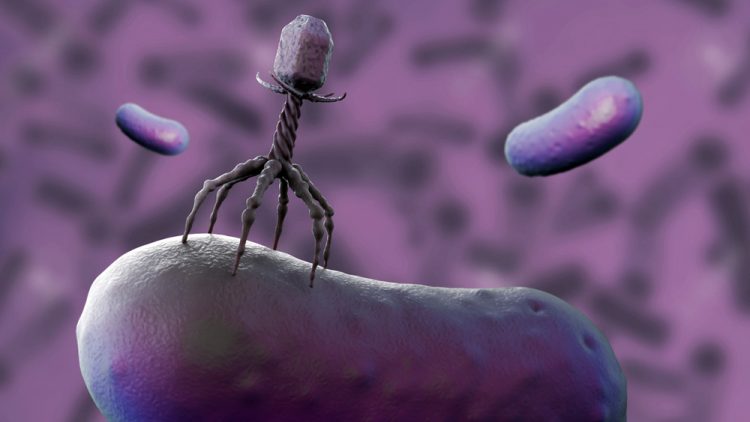New bacterial defense mechanism of the CRISPR-Cas system uncovered

When a virus is invading a bacterial cell, a defense mechanism called CRISPR-Cas is activated. Image: arinarici / iStock Quelle: University of Zurich
The CRISPR-Cas system is an immune system that is found in many bacteria. It provides protection from viruses and other molecular parasites that can invade the bacterium and take over its genome. In these systems, the immunity is mediated by a complex multi-protein molecular machinery that uses RNA molecules as molecular guides to recognize the invader and target it for destruction.
Until now, it has been known that the complex itself has nuclease activity – it can directly degrade the DNA and RNA of the invading viruses. Now, an international research team headed by Martin Jinek of the University of Zurich has found a new mechanism by which the invaders get destroyed.
Signaling molecule activates additional anti-viral enzyme
The targeting machinery of CRISPR-Cas systems is composed of RNA sequences derived from clustered regularly interspaced short palindromic repeats (CRISPR) and CRISPR-associated proteins (Cas). While the CRISPR RNAs recognize the genetic material of the invader, the Cas proteins cleave it like a molecular scissors.
In a subset of CRISPR-Cas systems (known as type III), the researchers made a surprising discovery. When the targeting machinery recognizes the invader, it synthesises a “second messenger”: a small, circular RNA molecule. This signaling molecule can diffuse within the bacterial cell and activates another RNA-degrading enzyme called Csm6, which then helps to destroy the RNA of the virus.
Similar mechanism as in human innate immune system
“In this way, when the CRISPR-Cas system in the infected bacterial cell becomes overwhelmed”, Martin Jinek explains, “it signals an alarm by means of the second messenger to get help from another defense mechanism to eliminate the virus.” In their study, the researchers were able to identify a unprecedented defense mechanism in bacteria.
Moreover, second messenger molecules produced by the CRISPR-Cas system have never been observed in nature before. Furthermore, the newly found bacterial defense mechanism has some unexpected similarities to a well-known antiviral mechanism that operates in the human innate immune system. “So bacteria, in their own way, fight viral infections in a way that is surprisingly similar to what human cells do”, Jinek adds.
Literature:
Ole Niewoehner, Carmela Garcia-Doval, Jakob T. Rostøl, Christian Berk, Frank Schwede, Laurent Bigler, Jonathan Hall, Luciano A. Marraffini, and Martin Jinek. Type III CRISPR-Cas systems produce cyclic oligoadenylate second messengers. Nature. 17 July 2017. DOI: 10.1038/nature23467
Contact:
Prof. Martin Jinek, PhD
Department of Biochemistry
University of Zurich
Phone: +41 44 635 55 72
E-mail: jinek@bioc.uzh.ch
http://www.media.uzh.ch/en/Press-Releases/2017/new-CRISPR-Cas-defense-mechanism….
Media Contact
All latest news from the category: Life Sciences and Chemistry
Articles and reports from the Life Sciences and chemistry area deal with applied and basic research into modern biology, chemistry and human medicine.
Valuable information can be found on a range of life sciences fields including bacteriology, biochemistry, bionics, bioinformatics, biophysics, biotechnology, genetics, geobotany, human biology, marine biology, microbiology, molecular biology, cellular biology, zoology, bioinorganic chemistry, microchemistry and environmental chemistry.
Newest articles

Simplified diagnosis of rare eye diseases
Uveitis experts provide an overview of an underestimated imaging technique. Uveitis is a rare inflammatory eye disease. Posterior and panuveitis in particular are associated with a poor prognosis and a…

Targeted use of enfortumab vedotin for the treatment of advanced urothelial carcinoma
New study identifies NECTIN4 amplification as a promising biomarker – Under the leadership of PD Dr. Niklas Klümper, Assistant Physician at the Department of Urology at the University Hospital Bonn…

A novel universal light-based technique
…to control valley polarization in bulk materials. An international team of researchers reports in Nature a new method that achieves valley polarization in centrosymmetric bulk materials in a non-material-specific way…





















